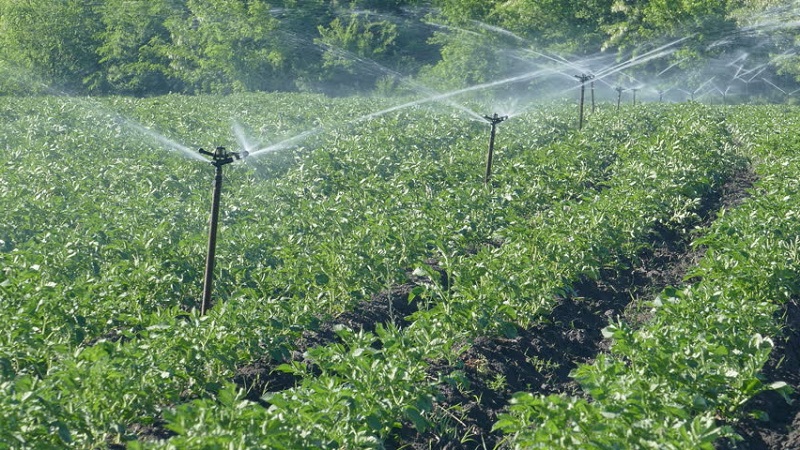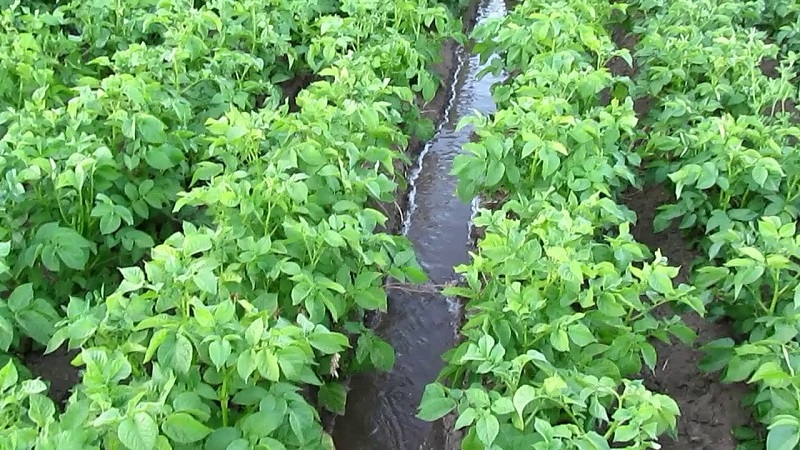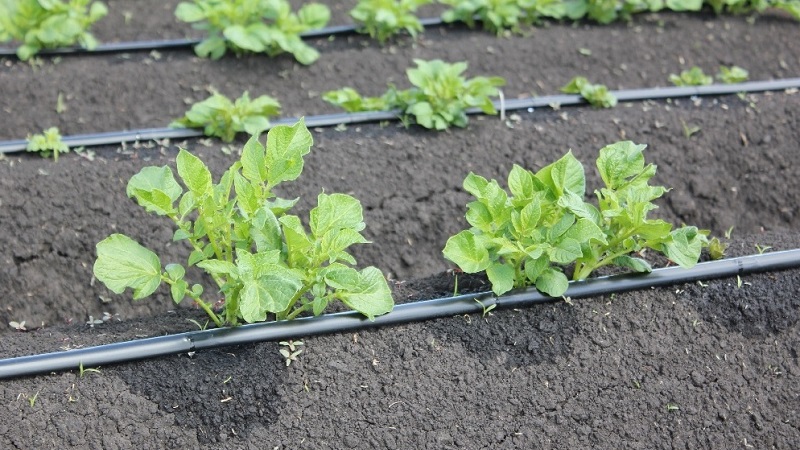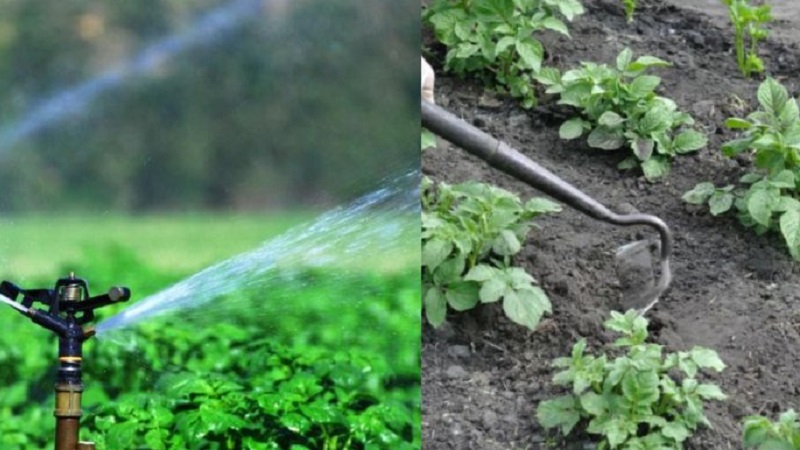Rules for watering potatoes during flowering
One of the reasons for the formation of small diseased potato tubers is excess or lack of moisture during the growth period. A competent watering regime, in particular during flowering, is one of the factors for a stable harvest.
In the article, we will talk about the rules for watering potatoes during flowering, about various methods and systems of irrigation, and also give useful advice from experienced gardeners.
The content of the article
Watering mode
Do I need to water the potatoes? Yes, but there are certain rules for watering.
Potatoes are planted in May when the soil is still sufficiently moist. Immediately after planting, the tubers form roots, the first shoots appear. Watering the plantings begins when the stems grow to 5-10 cm.
Need to know. Early watering is harmful to potatoes, as it leads to the formation of a shallow root system.
The first time crops are watered about a month after planting... Water is poured into the middle. Water consumption - 3-4 liters per plant. Watering is carried out fractionally, waiting for the absorption of each portion. The formation of puddles must not be allowed.

To moisten the soil, use settled water heated in the sun.... Until buds form, potato plantings are watered about once every two weeks. If it's hot, the gap is shortened.
Council. A simple way will help determine if it's time to water. If the soil next to the bush is dry at a depth of 10 cm and below, then it's time.
When organizing the soil moistening regime, they are guided by the following rules:
- use warm, settled water - the roots of potatoes are small and tender, the use of cold water can cause rot;
- watered in the morning or evening to avoid sunburn on the leaves;
- the frequency of watering depends on the structure of the soil - light soil is moistened more often, but in smaller doses, heavy - less often, but abundantly;
- the next day, the soil is loosened to saturate with oxygen - they do this carefully, trying not to damage the roots and tubers;
- observe the rate of 3-4 liters per bush - excess moisture is also harmful to potatoes, like a lack.
Watering potatoes during flowering
During the period of budding and the beginning of flowering, the formation of tubers begins in plants... The green part of the bush is already formed and the evaporating surface of the leaves is large, which means that the need for moisture increases.
If the end of spring and the beginning of summer are rainythen there is nothing to worry about. If not, then one cannot do without additional moistening of the earth.
Attention. Lack of moisture during the flowering period will cause the plant to use resources to grow greenery. As a result, the tubers will grow small and unsightly.
At this time, the potatoes are watered every 7-10 days.... Watering is also fractional, waiting for the complete absorption of moisture.
At the end of flowering, the need for moisture decreases, but the tubers still need water to build mass, because they themselves are 75% water.
Interesting on the site:
Growing potatoes according to the Chinese method
Signs of lack and excess of moisture
For potato plantings, not only the lack of moisture in the soil is destructive, but also its excess... The frequency of watering is determined based on weather conditions and actual soil moisture at a depth of 10 cm.
Important. Dropped lightened leaves, withering tops, non-opening buds, drying stems are signs of a lack of moisture.
With a lack of moisture, potato tubers stop gaining mass and seem to freeze. In this case, with further precipitation or watering, the potatoes grow, acquiring an irregular shape.

It also happens vice versa - there is too much moisture in the soil. It also harms plants. Dark watery drooping leaves indicate an excess of water in the ground., the appearance of weeping spots and plaque in the lower part of the stems, the development of fungal diseases, decay of roots and tubers.
For the timely detection of signs of a lack or excess of moisture, the planting is periodically examined.
During the period of prolonged rains in the aisles it is good to make drainage channels or furrows to drain excess water.
Watering methods
So, if the end of spring and the beginning of summer turned out to be dry, then it is necessary to water the potato plantings... But what is the best way to do this? Let's consider the main methods, their advantages and disadvantages.
Under the root
This is one of the manual watering methods. Water is poured into the middle of the bush in small portionswhile waiting for complete absorption.
Benefits:
- availability;
- the ability to control the flow of moisture to each bush;
- leaves and stems do not get wet;
- the ground remains loose.
disadvantages: high labor costs, the inability to use in large areas.
In the presence of a well with a pump or centralized water supply can be watered with a hose.
Benefits: no need to carry water containers.
disadvantages: watering with cold water can provoke rotting processes, it is easy to break fragile stems with a hose.
Along furrows
This the method is convenient if the landing site has a slight slope... The hose is placed in the furrow between the rows and the water flows by gravity to the end of the section. If there is no slope, the hose is periodically moved along the row.
Benefits: no need to stand with the hose while watering.
disadvantages: using a lot of water, crusting on drying and, as a result, the need to loosen.
Irrigation
it mechanical method of irrigation, which allows you to evenly distribute water over the surface of the beds.
Such an irrigation system is stationary with the organization of a branched pipeline and the installation of sprayers throughout the garden, as well as portable - from hoses, tees and sprinklers.
Useful advice... If you have a plot of irregular shape, then use sector sprinklers and sprinklers with a trunk rotation in a given sector. This saves water.
Benefits:
- uniform distribution of moisture over the entire area of the site;
- preservation of soil structure;
- improvement of the microclimate.
disadvantages:
- water ingress on the tops and stalks of potatoes, which creates favorable conditions for the development of fungi;
- flushing of fungicides and insecticides that can be used to treat plantings.

Drip system
Drip irrigation of potatoes is another mechanical method of irrigation, providing optimal moisture supply to the roots at all stages of growth.
Interesting fact. For the first time a drip irrigation system was applied in Israel. In the first year, the yield indicators almost doubled.
pros:
- economical spending;
- supply of moisture directly to the roots without loss of evaporation;
- preservation of soil structure;
- the ability to comply with the exact dosage of mineral fertilizers supplied to each bush.
disadvantages: high system cost. But when the costs are paid off quickly enough.
Dry watering
The so-called dry watering is loosening the soil and hilling potato plantings... After all, these procedures help to retain moisture in the soil for a longer time and contribute to its saturation with oxygen.
They begin to loosen after germination... The procedure is repeated the next day after watering or rain.
As soon as the potato sprouts rise 10-15 cm above the ground, the plants spud... In this case, the sprouts are almost completely covered with earth.Hilling is repeated 2-3 more times until buds appear.
Council. If the climate in your region is humid, it rains frequently in summer, then replace watering the potatoes with loosening. This will trap moisture in the soil and improve air flow to the roots.
After the buds appear, loosening is carried out neatly and superficiallyso as not to damage the formed tubers.
Manual watering
Manual watering applicable if potato plantings take up little space... Use a watering can or a bucket for it.
Benefits:
- the ability to use collected rainwater for irrigation;
- point impact;
- the ability to control the amount of water poured under each bush.
disadvantages: laboriousness and impossibility of using for large areas of planting.
Read also:
What to be guided by when watering
How to properly water the bushes for a rich harvest of healthy tubers? Be guided by three main factors:
- Climate - temperature and humidity, amount and frequency of rain. The less precipitation falls and the drier the air, the more often it is watered and vice versa.
- Soil - the composition and structure of the soil, its ability to retain moisture. It is known that sandy soil dries out faster than dense clay soils.
- Features of the variety - different varieties of potatoes have different needs for moisture.

A favorable combination of these factors allows you not to water the plantings at all... It is enough just to loosen and huddle the planting. But if the soil is sandy and the weather is hot and dry, then you can't do without watering.
The best time to water is in the evening.... Watering in the morning is also permissible, but the moisture on the leaves may not have time to dry before the heat arrives, and burns will appear on the tops.
The appearance of buds indicates that the plants have begun to form tubers.... During this period, the need for moisture increases, respectively, the frequency of watering is increased up to 1-2 times a week. For better absorption, water is poured in portions.
After flowering, the tubers gain weight... At this stage, it is important to observe the frequency of soil moisture and prevent it from drying out. Untimely and insufficient watering will lead to deformation of the potatoes.
With the appearance of the first signs of wilting of the tops, watering is reduced to once every 2-3 weeks... Drying of the stems signals that the crop is ripe and there is no need to water anymore.
Important nuances
Knowing the following important nuances will help you get a stable harvest smooth, healthy tubers every season:
- Uniform soil moisture. Potatoes do not like sudden changes in soil moisture. If you dry out the soil, and then water it abundantly, then the growth of potatoes will resume unevenly, and they will deform.
- Mulching potatoes. Covering the soil with a layer of mulch allows you to retain moisture in the soil for longer and, therefore, reduce the amount of watering. Mowed grass, green manure, straw are suitable as mulch. Over time, the mulch will rot and fertilize the soil.
- Early maturing crop varieties grow rapidly and absorb moisture more intensively. Therefore, insufficient soil moisture significantly reduces the yield of early potatoes.
- Planting of zoned varieties. For planting, choose varieties that are adapted to the climatic conditions of your region.
- Early landing. In spring, plant potatoes as early as possible, at a soil temperature at a depth of 10 cm + 6 ... + 7 ° С. This will allow you to make the most of the spring moisture.
Conclusion
Do I need to water the potatoes? Yes need. Sufficient soil moisture is an important condition for the development of potatoes during all periods of growth: from the emergence of seedlings to the growth of tubers.
By making the right effort to water properly, you will increase yields and reduce your risk of disease. However, keep in mind that excess moisture also harms the potatoes.